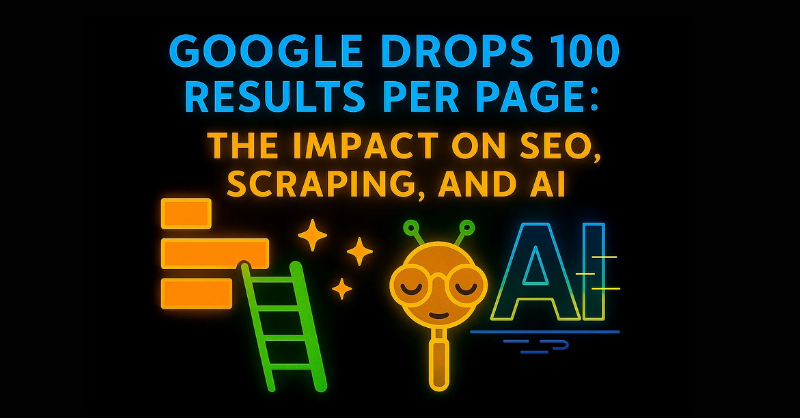If you’ve ever adjusted your Google settings to see 100 results on one page, you may have noticed that the option is gone. As of September 2025, Google quietly removed the feature. Instead of scrolling through a long list, searchers are now locked into smaller batches of results, usually around 10 at a time.
At first glance, this might feel like a small usability change. But for SEO professionals, digital marketers, and even AI developers, this shift carries bigger consequences than it seems. Let’s unpack what happened, why Google likely made the move, and what it means for your search strategy moving forward.
When Did Google Pull the Plug on the 100-Result Setting?
The update slipped in around mid-September 2025. Up until then, there were two ways to stretch your results:
- Adjust your search preferences to display 100 results.
- Add “&num=100” to the end of a Google search URL.
Both tricks stopped working almost overnight. Google didn’t make a splashy announcement, just a quiet confirmation that the option wasn’t something it planned to support anymore.
Source: Shutterstock
Why Google Removed Bulk Search Results
Google hasn’t given a detailed explanation, but the reasoning becomes clearer when you look at the bigger picture.
1. Limiting Search Data Scraping and LLM Training
The “100 results” setting was a dream for bots and scraping tools. One request could pull a huge chunk of Google’s index, which is handy for rank trackers, but also for large-scale data harvesters. By shutting this down, Google makes it harder for outsiders to collect search data in bulk. That includes companies building large language models (LLMs) and other AI systems.
2. Aligning Results Display with User Search Behaviour
Most of us never scroll past page one. In fact, the deeper you go into the results, the less likely anyone is even looking. From that perspective, showing 100 results at once didn’t really match how people search. By limiting the results, Google keeps reporting closer to reality.
3. Server Load and Global Search Efficiency
Pulling 100 results in a single page is heavy on Google’s servers. Splitting queries into smaller chunks spreads out the demand and ensures faster, more efficient searches worldwide.
How Reporting Metrics Shifted
For the average person searching “Tree cutting services” not much has changed. You’ll still see the most relevant results first. You’ll just have to scroll or click a little more if you want to dig deeper.
But for marketers and businesses, the ripple effects show up in the data:
- Impressions drop. Search Console now records fewer impressions because those inflated “extra views” from bots are gone.
- Average position improves. With fewer low-ranking impressions in the mix, many sites suddenly look like they’re ranking better.
- Traffic stays the same. Clicks and visits haven’t shifted. What’s changed is the way Google reports the numbers, not how customers find you.
So while your dashboard graphs may look different, your actual customer reach hasn’t taken a hit.

Source: Shutterstock
The Page Results Update and Its Ripple Effect on SEO
SEO Reporting Looks Different
If you’re tracking rankings and notice sudden dips in impressions or bumps in average position around September, this is why. It’s not your strategy changing overnight; it’s the data cleaning itself.
This could actually be a positive shift. Instead of chasing impressions from page 5 that no one ever sees, marketers can refocus on what really drives business: first-page rankings, clicks, and conversions.
SEO Tools Have to Adjust
The bigger challenge lies with rank-tracking platforms. Tools like SEMrush, Ahrefs, Moz, and SERanking built their reports around the ability to pull 100 results at a time. With that option gone, they’ve had to rethink how data is collected and delivered.
Here’s what’s shifting behind the scenes:
- Higher query load. Every “100 results” query now splits into up to 10 calls. SEMrush confirmed this jump, and industry analysts note the infrastructure cost could multiply by roughly tenfold. These extra API calls drive up platform costs and will squeeze tool budgets.
- Slower or incomplete data. More queries naturally slow down report generation. In fact, many rank-tracking tools “temporarily failed to gather comprehensive SERP data” right after the switch. Providers rushed in fixes, but initially, some deeper rankings went unreported or lagged.
- Rethinking tracking depth. Deeper results (pages 2–3) produce very little traffic, so many platforms are now prioritizing the most critical positions. For example, Semrush assures customers that its top 10 rankings (where most clicks happen) remain fully accurate. In practice, expect tools to cap reports at fewer results (like the first 20 or 50) and treat anything beyond as secondary data
For marketers, these shifts may show up as changes in your SEO dashboards. Some tools might stop displaying page-3 rankings or update certain keyword positions less often. Over time, even your billing could be affected; industry analysts predict providers will “inevitably” pass the higher data costs along through increased prices or tighter plan limits.
The AI Angle
There’s also a strategic play here. With AI overviews rolling out in search and LLMs hungry for training data, Google has every incentive to keep tighter control over its results. By limiting bulk scraping, Google makes it harder for outside players to build competing AI systems on top of its data, while steering users toward its own AI-powered search features.
So… What Should Businesses and Marketers Do Now?
Here’s how to approach the change without getting tripped up:
- Annotate your reports. Note the September change in your dashboards, so future reviews don’t misinterpret the sudden shift.
- Focus on meaningful metrics. Pay attention to clicks, leads, and conversions rather than raw impressions.
- Concentrate on page one. If most users never look beyond the first 10–20 results, that’s where your SEO strategy should live.
- Stay updated with your tools. Different SEO platforms are handling the change in different ways. Keep an eye out for new defaults, limits, or reporting methods.
- Prepare for AI search. With Google pushing AI overviews, it’s smart to optimize for visibility not just in traditional rankings but in how your content surfaces in AI-driven answers.
A Small Setting, and a Big Signal for SEO and AI
The removal of Google’s 100 results per page setting may sound like a small technical update, but it reflects much bigger trends. It cuts down on scraping, makes reporting more realistic, and reinforces Google’s shift toward AI-driven search.
For businesses, this is a reminder that SEO success isn’t about chasing inflated numbers or page-20 rankings. It’s about showing up where it matters: in front of real customers, on the first page, and increasingly, inside AI-generated overviews.
At TechWyse, we keep on top of these changes, so our clients don’t have to. Whether it’s navigating shifts in reporting, adapting to new search features, or planning for the future of AI in SEO, our goal is the same, helping businesses stay visible, competitive, and connected with the people searching for them. To book an appointment, call 866-208-3095 or contact us here.

